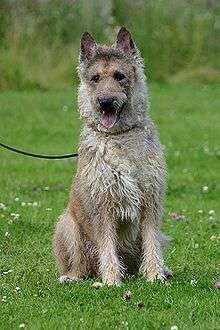Laekenois dog
The Laekenois is a breed of dog, sometimes classified as a variety of the Belgian Shepherd rather than as a separate breed. "Laekenois" is pronounced /ˈlækɪnwɑː/ LAK-en-wah.[1] The Belgian Laekenois breed was recognized by the American Kennel Club on 1 July 2020[2]. They can be shown in the United States, Great Britain, Canada, Australia, and throughout Europe, along with all three of the closely related breeds that share a heritage with the Laekenois: the Tervuren, the Malinois, and the Groenendael, the last being shown in the U.S. as the Belgian Sheepdog.
| Laekenois (Belgian Shepherd Dog) | |||||||||||||||||||||||||||||
|---|---|---|---|---|---|---|---|---|---|---|---|---|---|---|---|---|---|---|---|---|---|---|---|---|---|---|---|---|---|
 | |||||||||||||||||||||||||||||
| Other names | Belgian Laekenois Belgian Shepherd Dog (Laeken) Chien de Berger Belge | ||||||||||||||||||||||||||||
| Origin | Belgium | ||||||||||||||||||||||||||||
| |||||||||||||||||||||||||||||
| |||||||||||||||||||||||||||||
| Dog (domestic dog) | |||||||||||||||||||||||||||||
Appearance
Like all Belgian Shepherds, the Laekenois is a medium-sized, hard-working, square-proportioned dog in the sheepdog family with sharply triangular ears. The Laekenois is recognized by its woolly brown and white coat, intermixed so as to give a tweedy appearance. Most kennel clubs' standards allow for black shading, principally in muzzle and tail, indicating the presence of the melanistic mask gene.
History
The Belgian Laekenois originated as a dog for herding sheep at the Royal Castle of Laeken.[3] Besides its role as a herding dog, this breed is also used to guard linen that is placed in fields to dry. In the First and Second World War, the Laekenois was used a messenger dog .[4]
The Laekenois is considered both the oldest and the most rare of the Belgian Shepherd Dogs. Until the advent of dog shows in the early 1900s, the four varieties were freely intermixed, in fact, there are only three genes (short/long coat, smooth/wire coat, fawn/black coat) that separate the varieties genetically. Purebred Laekenois occasionally give birth to smooth-coated puppies, which, depending on the pure-bred registry, can be registered as Malinois.
The Laekenois is assigned to the American Kennel Club's Herding Group; from 2011 through 1 July 2020, it was assigned to the AKC's Miscellaneous Class.[2][5]
Health
See Health section of Belgian Shepherd for more information.
Activities
Laekenois can compete in dog agility trials, obedience, showmanship, flyball, tracking, and herding events. Herding instincts and trainability can be measured at noncompetitive herding tests. Belgian Shepherds exhibiting basic herding instincts can be trained to compete in herding trials.[6]
References
- "AKC MEET THE BREEDS®: Belgian Laekenois". Retrieved 11 September 2011.
- "Meet the Newest AKC-Recognized Breed: Belgian Laekenois". Retrieved 1 July 2020.
- "Belgian Shepherd Dog". Archived from the original on 8 October 2008. Retrieved 2008-10-23.
- "American Belgian Laekenois Association History". Retrieved 11 September 2011.
- "Belgian Laekenois Did You Know?". Retrieved 11 September 2011.
- Hartnagle-Taylor, Jeanne Joy; Taylor, Ty (2010). Stockdog Savvy. Alpine Publications. ISBN 978-1-57779-106-5.
External links
- Belgian Shepherd Dog Association of Great Britain
- The Northern Belgian Shepherd Dog Club
- Belgian Shepherd Dog Club of Canada Breed club for all four Belgian Shepherd breeds.
- Belgian Shepherd Dog Association of Finland
- American Belgian Laekenois Association
See also
| Wikimedia Commons has media related to Belgian Shepherd Dog (Laekenois). |